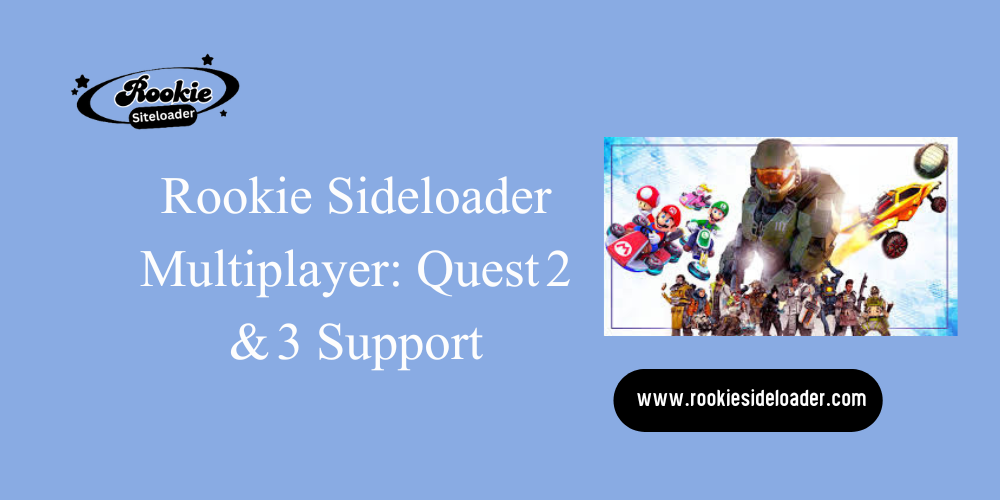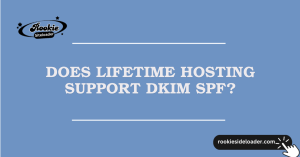Table of Contents
ToggleIntroduction
Multiplayer support is the single biggest question mark when you venture into the world of side loading. You’ve installed your content using Rookie Side Loader, but can you jump online with your friends?
The answer isn’t a simple yes or no. It depends entirely on how the game handles its networking. Since side-loaded content often bypasses official security and authentication checks, the traditional internet lobby experience usually hits a roadblock.
This guide clarifies the technical differences between game networking types. It outlines exactly what works and what doesn’t on both your Quest 2 and your newer Quest 3 headset. We’ll show you why understanding the networking model is far more important than just knowing how to use rookie sideloader.
By the end, you’ll have a realistic understanding of what to expect when seeking multiplayer action in the side-loaded community. We will also address why verifying is rookie sideloader safe before attempting any sensitive online activity is always a smart move.
Key Takeaways
- True, official online multiplayer requiring platform accounts is almost always blocked on side-loaded content.
- The most reliable form of multiplayer is “LAN-like” functionality, where players connect directly via IP addresses on the same network.
- Dedicated server games (like major MMOs) will fail because they require a valid, authenticated license check.
- Always ensure you are running an up to date Rookie side loader version to get the most stable files, reducing networking errors.
- Quest 3 offers a noticeable performance advantage, improving frame rate consistency in side-loaded multiplayer games.
- Never use a side-loaded copy to access an official online service tied to a primary, purchased account.

What Multiplayer Models Work on Side Loaders?
Understanding the networking models is the absolute foundation of grasping side-loaded multiplayer support. Games fall into two broad categories: those that use external, dedicated authentication servers and those that rely on simple peer-to-peer (P2P) connections. When you side load content, you effectively cut the communication link to the first type of server, specifically the ones that verify your purchase and identity.
Only the simplest connection methods, which don’t require external validation, stand a real chance of working. Therefore, our focus must be on identifying games that utilize these simpler, direct-connection architectures.
Why is LAN-like multiplayer the safest bet?
“LAN-like” multiplayer is overwhelmingly the safest and most reliable method for side-loaded content to achieve multi-user sessions. This model, which simulates an old-school Local Area Network connection, means that players connect to each other directly using their local IP addresses or through basic relay methods. Crucially, this type of connection does not require a central, official server to verify game ownership.
Instead, the network connection is established peer-to-peer. Both players are essentially talking directly to each other’s headsets. The game doesn’t need to ask the main platform server, “Hey, does this user own a legitimate copy?” because it’s not designed to rely on that check for basic connectivity. For enthusiasts asking how to use rookie sideloader for group play, this is the connection type you should actively seek out.
It’s a pure, unauthenticated network tunnel between known parties, making it highly effective for games that support this option. This simplicity is the key to its success in the side-loaded environment, offering near-guaranteed connection stability, provided all clients are running compatible software.
What about games that only use dedicated servers?
Games that exclusively rely on dedicated servers present a nearly insurmountable barrier for side-loaded content. A dedicated server is a powerful, persistent machine maintained by the game publisher. Its primary job is not just to host the match but also to perform the initial authentication handshake. This handshaking process involves verifying the user’s account ID against the official platform’s database.
If a game requires this persistent, validated connection, the side-loaded version which has bypassed the official store will fail at the very first hurdle. The dedicated server will instantly reject the connection because the necessary digital license or token, which is stored on the official platform’s servers, is missing or invalid.
Examples include large-scale MMOs, competitive shooters, and any title that features a seamless, persistent online world. Even if you knew how to use rookie sideloader to inject the game, the application cannot trick the dedicated, proprietary authentication server.
How does the network connection actually get established?
The network connection for side-loaded multiplayer is generally established through one of two mechanisms, both of which avoid proprietary authentication. The first is the direct IP connection method, where one player hosts a lobby and shares their device’s local network IP address with their friends. The friends then input that IP address directly into the game’s console or network settings to bypass automated matchmaking.
The second method involves community-supported P2P frameworks. In some cases, side-loading communities develop custom network wrappers or patches that substitute the official authentication check with a simple, open-source connection protocol. When you ensure you have an up to date rookie sideloader installation, you increase the chance that the provided game files include these community patches. Without these workarounds, the game would simply hang or crash when attempting to initialize network features that require official platform service calls.
Is Online Multiplayer Ever Truly Possible?
The short answer is: rarely, and with significant risk. When people ask if online multiplayer is possible, they usually mean connecting to the official, public lobbies filled with legitimate, purchased copies of the game. For side-loaded content, this is generally a hard no. The core issue is that every major VR and Android platform uses robust, multi-layered security protocols to link your device, your user account, and your game license before allowing access to public services. These authentication checks happen server-side and are impossible to bypass with a simple file transfer tool.
Why do official platform authentication checks fail?
Official platform authentication checks fail because side-loaded content, even if it is an exact copy of the game file, lacks the essential digital handshake token. When you purchase a game officially, the platform’s server tags your account with a license and generates a unique token for your device. The game is coded to send this token to the platform’s authentication server upon launch.
The side-loaded version, retrieved through a service like Rookie Side Loader, never received this token because the transaction never occurred. When the game sends a blank or invalid token to the official server, the server rejects the connection.
This refusal is automatic, immediate, and prevents access to public lobbies, friends lists, and official cloud services. The authentication process is the absolute wall that most side-loaded multiplayer attempts cannot climb over. This verification is designed to prevent piracy, and as such, it shuts down all unauthorized access attempts instantly.
What are the risks of using online services with side-loaded content?
The risks associated with attempting to use official online services with side-loaded content are substantial and should be taken very seriously. The primary risk is that the official platform’s security algorithms will detect the unauthorized connection attempt. This detection can lead to severe consequences for your primary account.
While the probability varies, consistent attempts to access verified lobbies can lead to a platform ban. This ban may not only affect your side-loaded content but also your legitimate purchases, potentially locking you out of your entire game library.
This is why knowing is rookie sideloader safe also involves understanding where its safety boundaries end it is safe for single-player files, but not for official online infrastructure. Users should maintain a clear separation: use side-loaded content offline or on community servers, and use purchased content for official online play.
How can I find community-run, private multiplayer servers?
Finding community-run, private multiplayer servers is the best, safe alternative for side-loaded online play. These private servers are often created by dedicated enthusiasts within the side-loading community itself. These servers run modified versions of the game’s network backend. They use open-source authentication methods rather than relying on the official platform’s servers.
You typically find these private server details, including IP addresses and custom connection instructions, within the official Rookie Side Loader Discord server. Look for channels dedicated to specific game mods or network tinkering. Before connecting, always ensure you have an up to date rookie sideloader installation, as these private servers often require the absolute latest version of the game file, which includes their custom patch. This method is the one legitimate path to playing side-loaded content with others online without risking a platform ban.
How Does Quest 2 Differ From Quest 3 Support?
While both the Quest 2 and Quest 3 run the same underlying Android operating system that Rookie Side Loader targets, there are crucial differences in hardware capability and firmware compatibility that affect the multiplayer experience. Since the Quest 3 is significantly newer and more powerful, it handles the demands of network-intensive side-loaded games better.
The Quest 2 remains fully supported by Rookie Side Loader, but the older hardware can sometimes introduce latency and frame rate issues in crowded multiplayer environments that the Quest 3 easily manages.
Is there a performance difference for side-loaded multiplayer?
Yes, there is a very noticeable performance difference between the two headsets when running side-loaded multiplayer content. The Quest 3 boasts a much more powerful processor and greater graphical capability. In a networked session, especially one involving many players or complex physics, the Quest 3 handles the load much more smoothly.
The Quest 2, being older, may struggle to maintain a consistent frame rate, leading to stuttering or lag, which significantly degrades the multiplayer experience. This isn’t a problem with how to use rookie sideloader; it’s a hardware limitation.
Better performance on the Quest 3 translates directly into lower latency and fewer dropped frames. This makes the session feel more responsive and less prone to network-related disconnects caused by the device struggling to process the data traffic fast enough.
What are the compatibility differences between the two devices?
The compatibility differences between Quest 2 and Quest 3 are generally minimal regarding the core functionality of side-loaded multiplayer, but they do exist in subtle ways. Since most side-loaded games are built for the Quest 2 baseline hardware, they function perfectly well on both. However, because the Quest 3 has newer firmware, it sometimes requires very specific, recently updated versions of the game file.
If a game is several months old and has not been updated in the side-loading library, it might run flawlessly on the older Quest 2 firmware but crash on the newer Quest 3 OS. This means always ensuring you grab the file from an up to date rookie sideloader source becomes even more critical for Quest 3 users. Always check community reports in the Discord to confirm Quest 3 compatibility before attempting to join a lobby, even in a LAN-like setting.
What are the Best Practices for Side-Loaded Lobbies?
Achieving successful multiplayer sessions with side-loaded content requires more diligence than simply hitting “Play.” You need to adopt a few essential best practices to ensure everyone in your party can connect without issues. These practices revolve around ensuring all participants are operating from the same baseline the same game version, the same side-loading application status, and a shared understanding of network troubleshooting. This is where truly mastering how to use rookie sideloader comes into play for social gaming.
Why is matching game versions essential for joining?
Matching game versions is absolutely critical, and neglecting this step is the second most common cause of connection failure after driver issues. In official multiplayer, matchmaking servers ensure all players are running the same, current patch. When side-loading, this automated check is absent. If Player A is running version 1.5.1 of a game and Player B is running version 1.5.3, the game’s network code cannot sync the disparate versions, leading to a host who is unable to see the joining player.
All players attempting to connect must download their content from the same source and ensure their Rookie Side Loader tool has confirmed the files are identical. Before attempting to host or join, verify with your group that everyone has downloaded the game from an up to date rookie sideloader library within the last few hours. This simple synchronization prevents hours of failed connection attempts and frustration.
How do I troubleshoot connection failures with a friend?
Troubleshooting connection failures with a friend requires a systematic approach to eliminate common network blocks and software mismatches. When a connection fails, follow this checklist immediately:
- Check IP: If connecting via IP, ensure the host shared their local IP address and not their public IP.
- Firewall: Both players should temporarily disable their PC’s firewall if the PC is being used as a bridge, or check the firewall settings on their router if they are connecting on the same network. Even if is rookie sideloader safe for your PC, the firewall may still block the game’s non-standard ports.
- Version Match: Confirm everyone is running the exact same version and patch (re-download from an up to date rookie sideloader source if necessary).
- Device Restart: Always restart both headsets after a failed attempt to clear any lingering network ghost processes or cache issues.
By following this logical progression, you can quickly isolate whether the problem is due to the game file itself or a localized network setting.
Conclusion: Manage Your Expectations for Online Play
The Rookie Side Loader community provides incredible access to content, but it cannot fundamentally change how a game is networked or bypass proprietary security protocols. True, official online multiplayer on Quest 2 and Quest 3 is generally not feasible with side-loaded files due to the official platform’s robust authentication checks.
However, the future is bright for P2P and community-run multiplayer. By knowing the difference between dedicated servers and LAN-like connections, always ensuring you have an up to date rookie sideloader file, and practicing meticulous version matching, you can unlock satisfying group play. Is rookie sideloader safe for multiplayer? Yes, as long as you use it to access community services, not official platform services. Manage your expectations, and you’ll find plenty of fun to share.
FAQs: Quick Answers on Multiplayer and Networking
Q: Why do I see other players listed in the game, but I can’t join their lobby?
A: You are likely seeing players listed on the game’s internal, global server list, which does not require authentication. However, when you try to join, the server attempts the essential license verification handshake, which immediately fails because your side-loaded file lacks the required token.
Q: Does using a VPN help bypass the authentication check?
A: No, a VPN only changes your geographic location (IP address). It does nothing to change the lack of a valid digital license token or the necessary authentication certificate that the platform’s proprietary servers require to let you into official lobbies.
Q: How can I confirm that my version of the Rookie Side Loader is up to date?
A: The up to date rookie sideloader application checks its own version against the official repository upon startup. If an update is available, it will prompt you. If you are ever unsure, check the dedicated #announcements channel on the official Discord server for the latest version number and official download link.
Q: What is the single biggest security mistake when attempting side-loaded multiplayer?
A: The biggest security mistake is attempting to log into a side-loaded game using your primary, purchased platform account credentials. Even if the game lets you, this action can directly alert the platform’s anti-piracy systems, potentially jeopardizing your official game library and account status.
This is why knowing is rookie sideloader safe means using it wisely.
Latest Post:
- Using Rookie Side Loader on Linux: A Complete Setup Guide
- Top Multiplayer Games on Rookie Side Loader: How to Play with Friends
- Rookie Sideloader Multiplayer Support: What Works on Quest 2 & 3
- Joining the Rookie Side Loader Community: Discord and Server Status Updates
- How to Create and Share Voice-Enabled Tutorials for Your Sideloaded Apps















